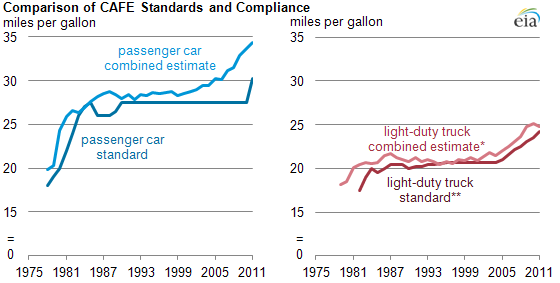
Fuel economy standards have affected vehicle efficiency

Notes: Combined means both foreign and domestic vehicles. Cars and station wagons fall under the category of passenger cars while all pickups, vans and sport-utility vehicles (SUVs) are classified as light-duty trucks. The compliance-tested estimate is an MPG value for all vehicle classes which is sales-weighted and includes earned CAFE trading credits.
*No combined compliance estimate is available for 1978
**Although standards for two-wheel drive and four-wheel drive light-duty trucks were set in 1978, it was not until 1982 that a standard was set for all light-duty trucks.
Immediately after Corporate Average Fuel Economy (CAFE) standards took effect in the late 1970s, new light-duty vehicle (LDV) fuel economy improved significantly, particularly in the case of passenger cars. This was followed by a long period during which fuel economy ratings (measured in miles per gallon, or mpg) for both cars and light-duty trucks leveled off. Since the early 2000s, the average fuel economy of all vehicles in the United States has again been rising.
The oil embargo of 1973-74 and the rise in oil prices during the early 1970s started a conversation in Congress over the fuel efficiency of U.S. automobiles. The Energy Policy and Conservation Act required an increase in passenger car fuel efficiency from 12.9 mpg in 1974 to 27.5 mpg in 1985 as well as improvements in the fuel economy of light-duty trucks. In the early 1980s, smaller cars were selling well, but by the mid-1980s, gasoline prices had decreased and several car manufacturers lobbied to have the CAFE standards reduced, as allowed under law. Such reductions are relatively rare, though. In 1986, the passenger car standard was reduced to 26 mpg, but either increased or remained flat in all years since. Similarly, the light-duty truck standard was reduced in both 1985 and 1990, but otherwise remained constant or increased.

As illustrated in the market sales share graphic, there was a substantial increase in the percentage of the LDV market made up by light-duty trucks during the 1990's. Light-duty trucks held a little less than 10% of the market share of light vehicles in 1979, and by 2000 they accounted for nearly 45% of the market, at which point the combined fleet-wide fuel efficiency of cars and trucks was down about one mile per gallon from 1990.
In 2003, CAFE standards were raised for light-duty trucks to 21 mpg by 2005, 21.6 mpg by 2006, and 22.2 mpg by 2007. In 2006, the formula used to establish CAFE standards for light-duty trucks was changed. Manufacturers were given the opportunity to comply with fleet-based standards or standards based on their sales-weighted "footprint" (wheelbase times track width). For Model Year (MY) 2011, a new footprint-based standard was enacted for both passenger cars and light-duty trucks. This new footprint standard required that all vehicle manufacturers improve their fuel economy at a similar rate, regardless of the types and sizes of vehicles sold. The sales-weighted compliance value of passenger cars for MY 2011 is estimated to be 34.4 mpg, while that of light-duty trucks is estimated to be 24.8 mpg.
In the Energy Independence and Security Act (EISA) of 2007, Congress called for the fuel economy of new LDVs to be increased by 40% by MY 2020, which is equivalent to a 35-mpg minimum for the total fleet of passenger and non-passenger automobiles. In 2009, CAFE standards set in 2007 were accelerated with a joint rule by National Highway Traffic Safety Administration (NHTSA) and the Environmental Protection Agency (EPA) and enforced through EISA and the Clean Air Act. The fleet-wide footprint standard (inclusive of all LDVs) calls for an estimated combined average mpg level of 34.1 by MY 2016, up from 27.3 mpg in MY 2011, an average annual increase of 4.3%. Additionally, the joint ruling establishes a projected greenhouse gas (GHG) emission standard that requires a reduction in fleet-wide CO2-equivalent emissions from 295 grams per mile traveled in MY 2012 to 250 grams per mile traveled in MY 2016.
The EPA's CO2-equivalent emissions standard allows manufacturers to generate credits by reducing GHGs through improved air conditioning systems and alternative fuel use capabilities, which NHTSA estimates will facilitate the achievement of the 34.1 mpg benchmark. However, because CO2-equivalent standards cover all vehicle emissions, if manufacturers do not implement technologies that affect non-fuel-related emissions, they will need to comply with the projected 35.5 mpg standard for MY 2016.
In December 2011, NHTSA and the EPA issued another proposed rule for improved standards for MY 2017-2025 that would require an average industry fleet-wide emission standard of 163 grams of CO2 per mile traveled. These improvements would come in two phases. The first would be enforced through 2021 and would require manufacturers to meet an average industry fleet-wide fuel economy basis of 40.9 mpg. The second conditional standard (based on current best estimates of maximum levels of stringency) will require an average fuel economy of 49.6 mpg by MY 2025.